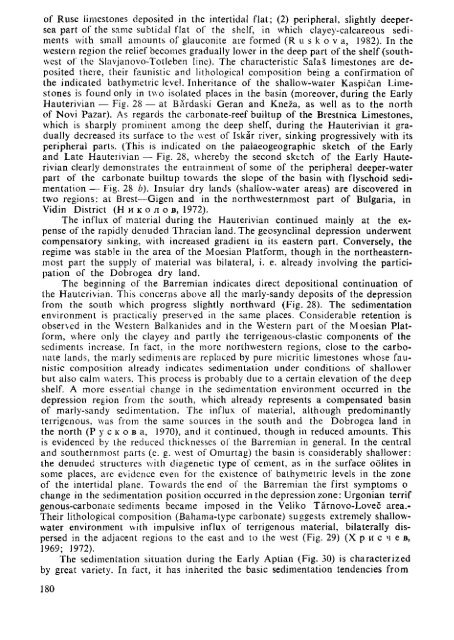THE MEDITERRANEAN LOWER CRETACEOUS
THE MEDITERRANEAN LOWER CRETACEOUS
THE MEDITERRANEAN LOWER CRETACEOUS
Create successful ePaper yourself
Turn your PDF publications into a flip-book with our unique Google optimized e-Paper software.
of Ruse limestones deposited in the intertidal flat; (2) peripheral, slightly deepersea<br />
part of the same sublidal flat of the shelf, in which clayey-calcareous sediments<br />
with small amounts of glauconite are formed (R u s к о v a, 1982). In the<br />
western region the relief becomes gradually lower in the deep part of the shelf (southwest<br />
of the Slavjanovo-Totleben line). The characteristic Salas limestones are deposited<br />
there, their faunistic and lithological composition being a confirmation of<br />
the indicated bathymétrie level. Inheritance of the shallow-water Kaspican Limestones<br />
is found only in two isolated places in the basin (moreover, during the Early<br />
Hauterivian — Fig. 28 — at Bardaski Geran and Kneza, as well as to the north<br />
of Novi Pazar). As regards the carbonate-reef builtup of the Brestnica Limestones,<br />
which is sharply prominent among the deep shelf, during the Hauterivian it gradually<br />
decreased its surface to the west of Iskâr river, sinking progressively with its<br />
peripheral parts. (This is indicated on the palaeogeographic sketch of the Early<br />
and Late Hauterivian — Fig. 28, whereby the second sketch of the Early Hauterivian<br />
clearly demonstrates the entrainment of some of the peripheral deeper-water<br />
part of the carbonate builtup towards the slope of the basin with flyschoid sedimentation<br />
— Fig. 28 b). Insular dry lands (shallow-water areas) are discovered in<br />
two regions: at Brest—Gigen and in the northwesternmost part of Bulgaria, in<br />
Vidin District (Николов, 1972).<br />
The influx of material during the Hauterivian continued mainly at the expense<br />
of the rapidly denuded Thracian land. The géosynclinal depression underwent<br />
compensatory sinking, with increased gradient in its eastern part. Conversely, the<br />
regime was stable in the area of the Moesian Platform, though in the northeasternmost<br />
part the supply of material was bilateral, i. e. already involving the participation<br />
of the Dobrogea dry land.<br />
The beginning of the Barremian indicates direct depositional continuation of<br />
the Hauterivian. This concerns above all the marly-sandy deposits of the depression<br />
from the south which progress slightly northward (Fig. 28). The sedimentation<br />
environment is practically preserved in the same places. Considerable retention is<br />
observed in the Western Balkanides and in the Western part of the Moesian Platform,<br />
where only the clayey and partly the terrigenous-clastic components of the<br />
sediments increase. In fact, in the more northwestern regions, close to the carbonate<br />
lands, the marly sediments are replaced by pure micritic limestones whose faunistic<br />
composition already indicates sedimentation under conditions of shallower<br />
but also calm waters. This process is probably due to a certain elevation of the deep<br />
shelf. A more essential change in the sedimentation environment occurred in the<br />
depression region from the south, which already represents a compensated basin<br />
of marly-sandy sedimentation. The influx of material, although predominantly<br />
terrigenous, was from the same sources in the south and the Dobrogea land in<br />
the north (P у сков a, 1970), and it continued, though in reduced amounts. This<br />
is evidenced by the reduced thicknesses of the Barremian in general. In the central<br />
and southernmost parts (e. g. west of Omurtag) the basin is considerably shallower:<br />
the denuded structures with diagenetic type of cement, as in the surface oolites in<br />
some places, are evidence even for the existence of bathymétrie levels in the zone<br />
of the intertidal plane. Towards the end of the Barremian the first symptoms о<br />
change in the sedimentation position occurred in the depression zone: Urgonian terrif<br />
genous-carbonate sediments became imposed in the Veliko Tarnovo-Lovec area.-<br />
Their lithological composition (Bahama-type carbonate) suggests extremely shallowwater<br />
environment with impulsive influx of terrigenous material, bilaterally dispersed<br />
in the adjacent regions to the east and to the west (Fig. 29) (Хрисчев,<br />
1969; 1972).<br />
The sedimentation situation during the Early Aptian (Fig. 30) is characterized<br />
by great variety. In fact, it has inherited the basic sedimentation tendencies from<br />
180

















